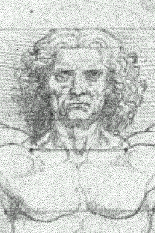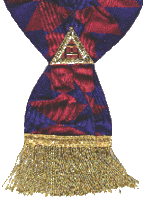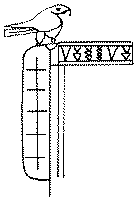The First and Second Standards on the Narmer Plate.
The "set-square" is an Ancient Egyptian hieroglyph for "Pharaoh".
A "Hawk on a Standard" is an Ancient Egyptian hieroglyph for "God".
More than communion with the elements of earth, air, fire and water Leonardo's self portrait represents the Precession of the Equinoxes as outlined in Part 5: The Royal Arch of the Ages of the Zodiac.
The Royal Arch of Precession of the Ages of the Zodiac
The reason Precession occurs is that the Earth not only rotates on its axis … otherwise known as the Axis Munde or World Pillar … it also wobbles. This wobble effect is a phenomenon caused by forces exerted by the Sun on the bulges of the Earth at the Equator.
The wobble effect is best explained in terms of a spinning top. As the top begins to lose momentum it begins to wobble. It is this same kind of circular movement, or wobble, of the Earth, which moving at a constant speed over long periods of Time alters the direction of the Polar Axis. One revolution is completed every 25,920 years. The central point of revolution is called the "pole of the ecliptic".
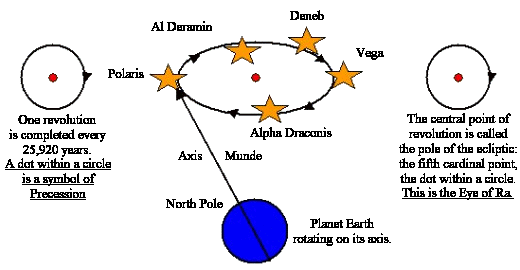
The visible effect of Precession on the Pole Star.
The wobble effect is best explained in terms of a spinning top.
As the top begins to lose momentum it begins to wobble.
The apparent cycle of the Pole Stars over a period of 25,920 years is not the only effect of Precession as viewed from Planet Earth. Another effect with which most of us will be familiar is the apparent movement of the Signs of the Zodiac across the sky on an annual basis. It is reasonable to suspect that most of you reading this will be familiar with the Sign of the Zodiac under which you were born, and many of you will read your stars in newspapers and magazines everyday. You might be an Aries or a Libra. Or perhaps like me you are a Scorpio.
The apparent movement of the Signs of the Zodiac across the sky does not only take place on an annual basis however. The cycle also occurs over a period of 25,920 years, often referred to as Plato's Great Year.
The following diagram can be interpreted on both of these levels, but the main emphasis is on the Great Year … the Four Seasons, the Twelve Ages and the Precession of the Equinoxes. The twelve markers indicating the timing of the Sun entering a New Age and / or Season of the Zodiac are like "flags" denoting the boundaries. In fact they could be considered as "flagships" heralding in each of the New Ages and / or Seasons.
The ensigns of the twelve Zodiacal Constellations, representing the Twelve Ages in the Precession of the Equinoxes, appear to arch their way across the sky as if in royal procession. The beginning of a new Zodiacal Season is marked by the standards of the Lion, the Bull, the Man and the Eagle … sometimes equated with the Four Cardinal Directions. The Fifth Cardinal Direction is the central point of revolution, the pole of the ecliptic.
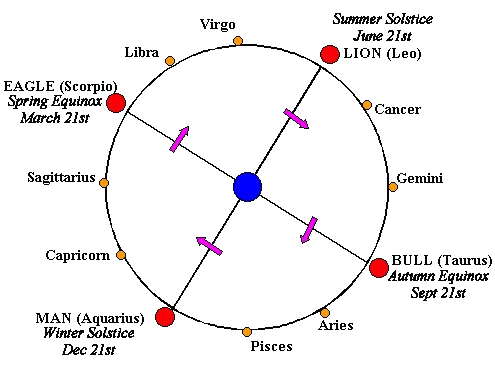
The Royal Arch of the Ages of the Zodiac.
The ensigns of the twelve Zodiacal Constellations, representing
the Twelve Ages in the Precession of the Equinoxes,
appear to arch their way across the sky as if in royal procession.
The beginning of a new Zodiacal Season is marked by
the standards of the Lion, the Bull, the Man and the Eagle.
The blue dot within the circle is Planet Earth around which the Constellations of the Zodiac appear to revolve. The "Cross" which is formed by the four quarters of the circle takes 25,920 years to complete one revolution. The completion of one revolution is referred to as a Great Year.
Within this Great Year are four Seasons, which are defined by the Spring, Summer, Autumn and Winter Equinoxes. For this reason the Great Year is also referred to as the Precession of the Equinoxes. Within each Season are three Ages. For example, within the Zodiacal Season of Taurus there are the three Ages of Taurus (the Bull), Aries (the Ram) and Pisces (the Fish). Within the Zodiacal Season of Aquarius there are the three Ages of Aquarius (Man), Capricorn (the Sea Goat) and Sagittarius (the Archer). Each Zodiacal Season comprises a 90-degree right-angle … like a set-square. Each Zodiacal Season is a one fourth part of a circle and, like Leonardo da Vinci, is standing on the square.
Although he was not technically a Freemason Leonardo was, perhaps not surprisingly, a member of the Prierre de Sion., the Priory of the Sun. As such he would have been well aware of the Royal Arch of the Ages of the Zodiac and the concept of Precession. At the time however it would have been considered heresy to admit to such knowledge.
When the five-pointed star is circumscribed by a circle, as it was in Da Vinci's illustration, it becomes a pentacle. It is uncanny that Nature has reproduced this Sacred Geometry in France, near Rennes-le-Chateau, in the form of five mountains virtually equidistant around the circumference of a circle. Rennes-le-Chateau appears as an Ancient Site on my Star Map "Venus" and is closely associated with the Priory of the Sun.
Like the circle, the "endless knot" of the five-pointed star denotes "eternity". There is no beginning and no end.
The "Pi" Ratio: the Golden Mean.
The regular five-pointed star is important in geometry because it encodes the "pi" ratio, alternatively named the "Golden Mean".
Pi in numerical terms is expressed as 3.14159265 to the nearest eight decimal places.
The pi ratio in the five-pointed star, the pentalpha, is encoded in the lines of the pentagon framing the star and in the tangent lines of the star itself. The ratio of one star tangent line (pink) to one pentagon line (green) is:
Ø = (1 + 5)/2 = 2cos(pi/5) = 1.61803 … and this is the "Golden Ratio".
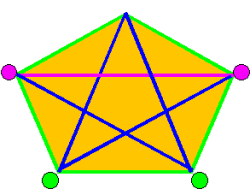
The ratio of one star tangent line (pink) to one pentagon line (green) is:
Ø = (1 + 5)/2 = 2cos(pi/5) = 1.61803 … and this is the "Golden Ratio".
"Pi" and the Ancient Egyptians
Usually the discovery of "pi" is attributed to the Ancient Greeks, the Pythagoreans having adopted the pi symbol as their emblem. In fact it was the Ancient Egyptians who discovered pi as attested on the Narmer Plate dated 4468BC.
Around his neck Sirius, the "King of the Seven Stars", is wearing the double tau, the "pi" symbol. From the Tau hieroglyph in the Ancient Egyptian Book of the Dead it is clear that "Tau" means "holy or sacred gate" or "holy or sacred opening". The five-pointed star denotes the word "sacred".
|
The Narmer Plate 4468BC: the King of the Seven Stars
is wearing the pi symbol around his neck.
The reason the five-pointed star was considered sacred was because it was a symbol which encoded the Secret of Precession as well as the Golden Mean. The number of degrees around the centre point of the star (360) divided by the number of arms of the star (5) renders the number seventy-two … which is significant in terms of astronomy (see Part 4) and Freemasonry.
Seventy-two is the number of years that it takes for the sky bodies to appear to move through one degree of their cycle. When the seventy-two years are multiplied by the three hundred and sixty degrees of the complete cycle, we discover that it takes is 25,920 years for each heavenly cycle to be completed … at which time the process starts all over again. This is the cycle of Precession.
In Freemasonry the number seventy-two is significant, as traditionally the angle at which the Masonic Compasses stand is 72 degrees.
The Five-Pointed Star and Freemasonry
Further examples of the five-pointed star being associated with Freemasonry include the Master of the Lodge being represented by this symbol. Moreover it was traditionally an emblem of the early Masonic Guilds because they were unified in their application of the Sacred Geometry of the Golden Ratio in the building of the great cathedrals of Europe.
Indeed Geometry was synonymous with Masonic Guilds or Freemasonry. Geometry is referred to as the "fifth science" while the Supreme Being is referred to as the Grand Geometrician. A Second Degree Fellow Craft Freemason is referred to as a "G Man", the "G" referring to Geometry. The following comes from ritual dating back to 1730.
Q: Why was you made a Fellow-Craft?
A: For the sake of the letter G.
Q: What does G denote?
A: Geometry or the Fifth Science.
The Heavenly G.
A few years ago when Freemasonic Temples were open to the public in South Australia the letter G was evident, suspended above eye level. I was told that it stood for God and Geometry.
To determine the position of the Heavenly G we begin our journey in the constellation of Taurus. After locating the bright red star of Alderbaran arc north-west through the Gemini Twins, Castor and Pollux, and on to Procyon in Canis Minor. From there move directly on to the brightest star in the heavens, Sirius, in the constellation of Canis Major. We continue the G-curve through to Rigel, at the mouth of the Celestial Sphinx, and then continue in a straight line, passing to the right of the middle star of Orion's Belt until we reach the end of our journey at Betelgeus, more commonly known as Beetle Juice.
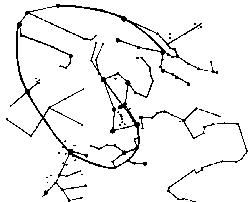
The "Heavenly G' in the Northern Winter Skies.
Today it stands for God and Geometry.
God, the Creator, in 14000BC was the Celestial Sphinx.
It is significant that the final line of the Heavenly G is a straight line and that it passes through the Constellation of Orion, which was considered by the later Ancient Egyptians as being Sahu, the soul of Osiris who represented the Axis Munde around which the heavens appeared to revolve. (See Part 6) More important at this point however is its symbolism as a link between the celestial and terrestrial worlds. A link between God and Man.
This link is clearly demonstrated in the star chart above: God, the Celestial Sphinx, is linked literally with Man, the Giant Orion. This same link between God and Man was reproduced at Giza in the form of the Sphinx and the Three Pyramids. The Sphinx was the earthly representation of the Celestial Sphinx and the Three Pyramids were the earthly representation of the Belt of Orion and, by extension, of the Giant Orion himself.
(The ground plan of the Three Pyramids of Giza was discovered to be a replica of Orion's Belt by Robert Bauval in November 1983. Ref: Bauval, R & Gilbert, A The Orion Mystery. Mandarin, London 1994)
There is the possibility that the actual meaning of the letter G in Freemasonry is not as important as the fact that it exists. Ego: I exist, I am ... which relates back to the God of the Old Testament telling Moses "I AM THAT I AM" ... "I AM hath sent me" (Exodus 3 v 14). In this sense the letter G would represent the Great I Am, God himself. In 14000BC God was the Celestial Sphinx.
In an expose of 1730 when the letter G was a symbol of the Second Degree Fellow Craft the following ritual was recorded:
Q. When you came into the middle, what did you see?
A. The Resemblance of the Letter G.
Q. Who doth that G denote?
A. One that's greater than you.
Q. Who's greater than I that am a Free and Accepted Mason, the Master of a Lodge?
A. The Grand Architect and Contriver of the Universe, or He that was taken up to the Top of the Pinnacle of the Holy Temple.
The initial question "When you came into the middle, what did you see?" refers to the Winter Skychart for the Northern Latitudes looking South for the dates of the year October 15th through to April 1st. The most prominent date and time among these is January 1st at midnight as the New Year is being welcomed in at which time the Heavenly G is high in the centre of the night sky. The reply given to the question is fully accurate: "The Resemblance of the Letter G." Notice that the Heavenly G does not have the horizontal bar.

On January 1st at midnight as the New Year is being welcomed in
the Heavenly G is high in the centre of the night sky.
Notice that the Heavenly G does not have the horizontal bar.
Interestingly the second question asks who, not what, the G denotes, and receives the correct reply "One that's greater than you." This person is further clarified as being "The Grand Architect and Contriver of the Universe." In other words the person who was responsible for the allocation of the constellation patterns to the night skies, the person who gave pattern and form to an otherwise chaotic cosmos. As we discovered in Part 2 this person can only refer to the Celestial Sphinx, the Creator. In turn the Celestial Sphinx was the brainchild of the remote Ancient Egyptians prior to 14000BC.
The second description of whom G denotes: "He that was taken up to the Top of the Pinnacle of the Holy Temple" suggests that the Holy Temple is the Celestial Dome. It follows that the Pinnacle of the Holy Temple can only be the Celestial North Pole. This would confirm the Grand Architect and Contriver of the Universe as having recognised the existence of a Celestial North Pole and the apparent rotation of the stars in the night skies around it. According to Ancient Egyptian Memphite teaching Ptah filled this prestigious position.

Ptah was often depicted raised on a pedestal which was to be
found in the Naos of a temple. The Naos, like the oak tree,
was considered to be the centre of the universe.
Ptah was often depicted raised on a pedestal which was to be found in the Naos of a temple. The Naos, like the oak tree, was considered to be the centre of the universe. Ptah, who usurped Osiris' role as the World Pillar, was symbolic of the Axis Munde around which the heavens appear to revolve. He was the link between the celestial and terrestrial worlds.
Not surprisingly therefore, in his hands he holds an upright staff, a composite sceptre uniting the emblems of life, stability and omnipotence. Ptah is not only the personification of the final straight line of the "Heavenly G" he is also the personification of Precession.
Footnote … subtle references to Freemasonry are intentional.
Copyright Audrey Fletcher 1999
All rights reserved
Adelaide, South Australia
|




